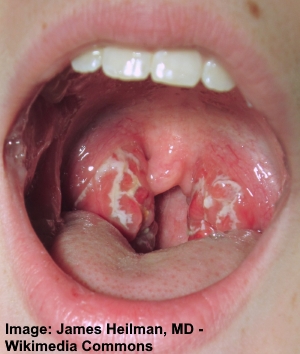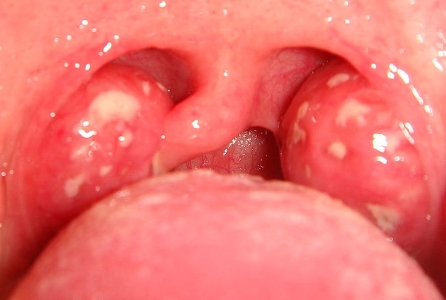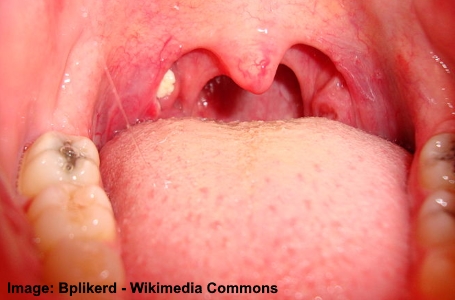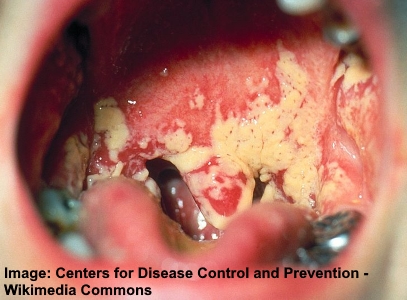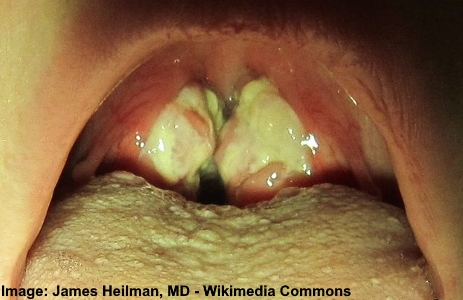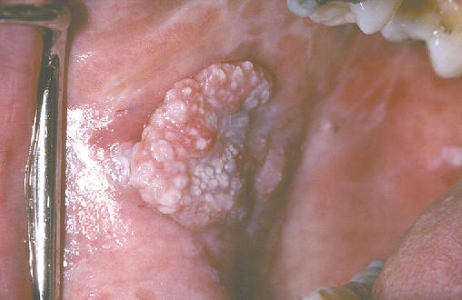White Spots on Throat: 6 Common Causes (Images Included)
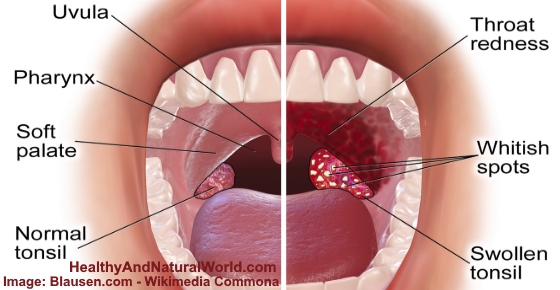
White spots on throat are usually a symptom of a viral or bacterial infection. If you have white patches on your throat, you will probably have other symptoms as well.
Some of the accompanying symptoms of white spots in throat could be:
- White spots on the tonsils which are inside the throat
- Swollen glands in your neck
- Sore throat
- A dry throat
- Unpleasant taste in mouth
If you notice white patches on your throat or on your tonsils then it is always best to have them checked out because, left untreated, they can lead to more serious conditions. However, there are many natural remedies you can use to help ease the discomfort associated with throat infections.
If you have noticed white dots on your throat, what are the main causes of them?
What Causes White Spots on Throat?
There are a number of different reasons why white spots or patches can appear on your throat or tonsils. Here are the most common reasons:
1. Strep Throat Can Cause White Patches in The Back of Throat
One of the reasons for the appearance of white spots on the throat is a bacterial infection called strep throat. It is caused by Streptococcus pyogenes bacteria.
Although strep throat mainly affects children and teenagers, it can also affect adults. While one of the symptoms of a strep infection is a sore throat, it only accounts for around 30% of throat infections in children and about 10% in adults.1
Apart from causing your throat to be sore, some of the other symptoms of strep throat are:
- Pain when you swallow
- A fever
- Swollen tonsils and lymph nodes
- White spots or red sores on tonsils
Family physician, Dr. Kathleen Romito, says that if you have cold symptoms like a blocked or runny nose and sneezing, then you probably don’t have a strep throat.2
How to treat strep throat naturally
There are many natural remedies which can help to treat mild to moderate cases of strep throat.
However, if you have a more serious case, you should always seek medical advice. If left untreated, strep throat can lead to serious infections in other parts of the body because the bacteria can spread to other organs. The most serious complication of strep throat is rheumatic fever.3
Even if your doctor has prescribed a course of medications to treat strep throat, you may still use natural remedies alongside to help the treatment (but remember to consult with your doctor about it).
One of the natural remedies for strep throat is cayenne pepper. Cayenne pepper contains capsaicin which has proven antibacterial properties. For example, a study published in Frontiers in Microbiology found that capsaicin was effective against Streptococcus pyogenes bacteria and it can help prevent the infection spreading to deep tissues.4 It is also effective in relieving pain5 and reducing inflammation.6
You can make a paste with cayenne pepper by mixing 1 teaspoon with half a cup of coconut oil or other carrier oil, or buy a ready made cream in the drugstore.
Because capsaicin is strong and might hurt your throat, and since it is well absorbed by your skin, apply the capsaicin cream or paste to the skin on your throat and on the swollen lymph nodes on your neck.
For more information, please read my article about the best natural remedies for strep throat.
It is good to remember that strep throat is highly contagious and you should make sure that you wash your hands often and cover your mouth if you cough. Avoid sharing utensils like cups, knives, and forks.
2. Tonsillitis can Cause White Spots on Tonsils and in the Back of Throat
Tonsillitis can cause white spots in your throat and on your tonsils. Tonsillitis happens when the tonsils, the 2 lymph nodes located at the back of your throat, become infected and inflamed. It can be caused by a bacterial infection (like streptococcal bacteria) or a viral infection.
Other symptoms associated with tonsillitis are a sore throat, fever, headache, stiff neck, and swollen tonsils. Quinsy is a complication of tonsillitis and it causes pain on one side of your throat.
It is important to diagnose the cause of tonsillitis because if it is caused by a serious bacterial infection, antibiotics may be needed. If you take antibiotics, make sure to do these 3 things to restore healthy intestinal flora.
If the tonsillitis is caused by a virus then very often natural remedies can help to treat and relieve the symptoms.
Natural treatments for tonsillitis
One of the most effective natural ways to treat tonsillitis is to gargle with salt water. All you have to do is to mix 1/2 to 1 teaspoon of salt in an 8 oz glass of water. Gargle several times during the day.
You can also make a delicious Echinacea tea by steeping Echinacea and ginger in hot water. When it has cooled add some lemon and honey and drink 2-3 times a day. All of these ingredients can help to relieve tonsillitis. For more detailed information, read my article on how to use Echinacea tea for a great health.
If you want to find out more ways to treat tonsillitis, then please read my article about the best home remedies for tonsillitis.
3. Tonsil Stones (Tonsilloliths) Look Like White Bumps on the Back of Throat
Tonsilloliths, also known as tonsil stones look like white spots or balls on the back of the throat.
Depending on their size, tonsil stones could also irritate the back of your throat and they often get coughed up into the mouth. Tonsil stones can be physically irritating, leaving you feeling as if something is stuck in your throat.
Tonsil stones are actually white formations on your tonsils at the back of your throat. This white stuff or chunks form when “debris” like bacteria, mucus, food and dead skin cells get trapped in and around your tonsils. In time they calcify, causing them to look like small white bumps on your tonsils. However, many people with tonsil stones can’t see them.
One common symptom of tonsil stones is chronic bad breath. This is because tonsil stones are full with bacteria that pack quiet a stinky smell and distinct odor. A study published in the British Dental Journal found that 75% of people with halitosis (chronic bad breath) also had tonsilloliths.7
Other common symptoms of tonsil stones can be sore irritated throat, swollen red tonsils, earache, and in extreme and rare cases difficulty breathing.
A Japanese study that conducted by researchers at the Tokushima University in 2014 found that tonsil stones is a common condition that occurred in close to 40% of patients, with the prevalence increasing with age. It is more common among people who have suffered from tonsillitis and inflammation of the tonsils.
Common causes and treatments for tonsil stones
Although tonsil stones may happen to even the healthiest mouth and to people of any age, they are more common in those who have insufficient oral hygiene and in teenagers or people with larger tonsils (more surface area means more room for stones to build up).
One of the best ways to prevent tonsil stones forming is to practice good oral hygiene. This means brushing your teeth twice a day, regularly flossing, and brushing your tongue. This can help to remove bacteria and the “debris” that can come together to form stones.
If you have tonsil stones, there are a number of natural ways to get rid of them. Sometimes, just a salt water gargle is enough to help dislodge the stones.
If you want to know how some people have been able to dislodge tonsil stones using a cotton swab (or a toothbrush), then please read my article on the top natural ways to remove and prevent tonsil stones.
4. Oral Thrush Looks Like White Patches or Clumps on Back of Throat
Oral thrush can appear as white patches on your throat, tongue, tonsils, and roof of your mouth and can leave you with a ‘cottony’ feeling in your mouth.
Oral thrush is usually a result of yeast infection that is caused when there is an imbalance of “good” bacteria in the body and it allows fungal infections to develop. For example, a Candida fungal infection in the mouth is an example of oral thrush.
The Mayo Clinic reports that one of the most common reasons for oral thrush is taking antibiotics, which disrupt the balance of bacteria in your body.8
If you are taking antibiotics then it is recommended that you also take probiotics to help restore the natural flora in your digestive system. This can help prevent outbreaks of oral thrush. A study published in the journal Critical Care Medicine showed that probiotics helped to prevent candida infections while children were taking antibiotics.9
You can also consume fermented foods to boost the good gut bacteria and improve digestive, cardiovascular and immune health.
Another option for treating oral thrush is coconut oil and this is due to its antifungal properties. For more information, read my ultimate guide on how to use coconut oil for oral thrush and yeast infections.
5. Mononucleosis can Cause White Spots on Tonsils
Mononucleosis (sometimes just called mono) is a contagious viral infection which can cause white spots on your tonsils and in your throat.
Some of the other symptoms of mononucleosis are fatigue, sore muscles, headaches, and a loss of appetite.
Mononucleosis is caused by a virus (Epstein-Barr virus, or EBV) and although it isn’t a serious illness, it can affect a person’s daily activities.
Mononucleosis is a very infectious disease and it tends to affect mainly teens and young adults. However, most adults already have antibodies against mononucleosis which prevent them from catching it again. Mononucleosis is generally spread by saliva and is sometimes referred to as the “kissing” disease.
One of the symptoms of mono is sore throat, often with white patches on the tonsils (which may look like strep throat). Other symptoms of mono are fever, swollen lymph nodes, headache and fatigue.
Dr. E. Gregory Thompson from WebMD said that one complication with mono is an enlarged spleen, and it is recommended that people with mono avoid lifting heavy items and engaging in contact sports to reduce the risk of spleen injury.10
If you have mononucleosis the best course of treatment is plenty of rest and to drink plenty of fluids. If you have a sore throat, then you can use natural treatments such as calendula tea, homemade syrup or natural pain killers (that you may already have in your kitchen).
6. Leukoplakia can Cause white Patches in the Throat
Leukoplakia is a less common condition which can cause white spots on throat and mouth.
Mild leukoplakia isn’t classed as a dangerous disease and will usually go away on its own. However, on rare occasions, more serious cases have been linked to oral cancer.11 It is common in people who smoke or chew tobacco, although it can also be caused by other irritants in the mouth.
Leukoplakia can sometimes be caused by gastroesophageal reflux disease (GERD). This is where the acid from the stomach comes back up into the esophagus. Common symptoms of GERD are heartburn or acid indigestion. A study published in Medscape General Medicine said that GERD can also cause leukoplakia.12
Doctor of dental surgery, Dr. Michael Friedman recommends removing the source of irritation. This can mean that a person stops smoking or using other tobacco products.13 If the dentist or doctor thinks that it is a serious case, then a biopsy may be taken. However, most cases of leukoplakia are mild and go away on their own.
Read these related articles:
1. The Best Natural Remedies for Strep Throat
2. The Best Home Remedies for Tonsillitis
3. Tonsil Stones: Top Natural Ways for Removal and Prevention
4. Bumps in Mouth: Causes, Symptoms and Natural Treatments
Resources:
1.Acute sore throat.
2.Strep throat.
3. Strep throat – what happens.
4. Antimicrobial activity of capsaicin against streptococci.
5. Capsaicin: a review of its clinical applications.
6. Capsaicin exhibits anti-inflammatory property.
7. The presence of tonsilloliths and halitosis in patients.
8. Causes of oral thrush.
9. Probiotics in prevention of candida.
10. Mononucleosis.
11. Dental health and leukoplakia.
12. Manifestations of gastroesophageal reflux disease.
13. What is the treatment for leukoplakia?
2.Strep throat.
3. Strep throat – what happens.
4. Antimicrobial activity of capsaicin against streptococci.
5. Capsaicin: a review of its clinical applications.
6. Capsaicin exhibits anti-inflammatory property.
7. The presence of tonsilloliths and halitosis in patients.
8. Causes of oral thrush.
9. Probiotics in prevention of candida.
10. Mononucleosis.
11. Dental health and leukoplakia.
12. Manifestations of gastroesophageal reflux disease.
13. What is the treatment for leukoplakia?

